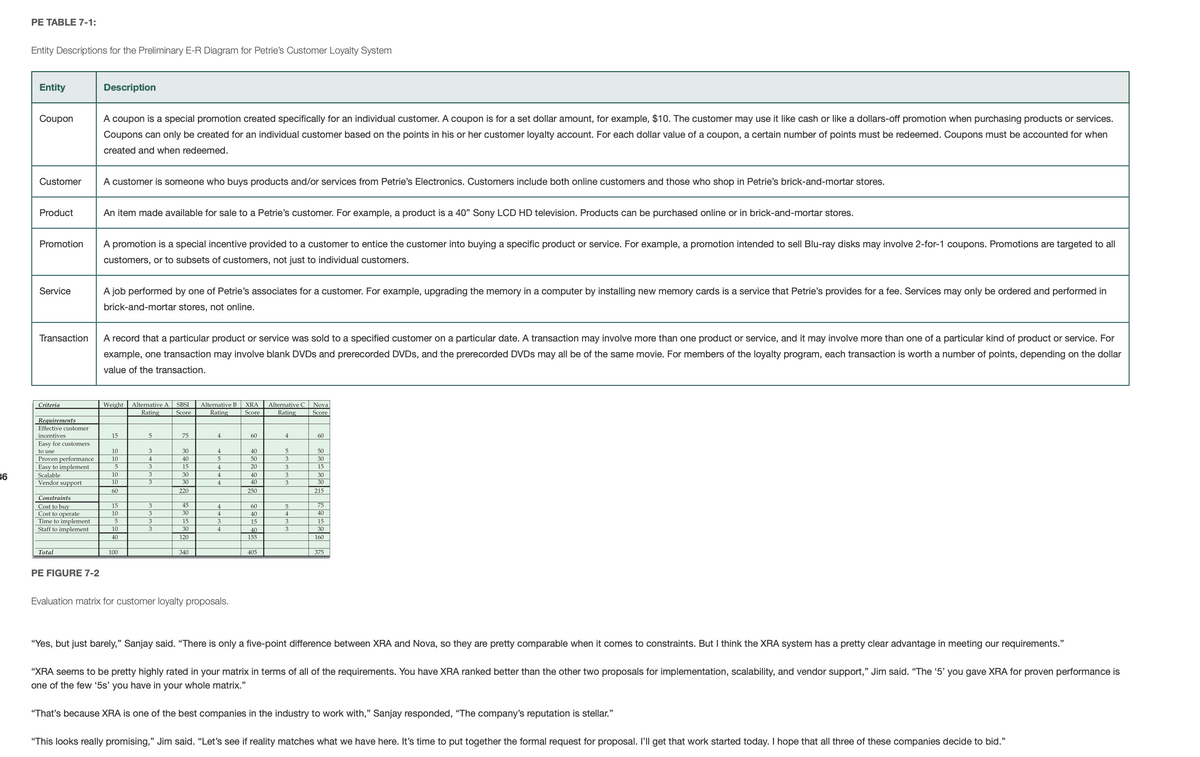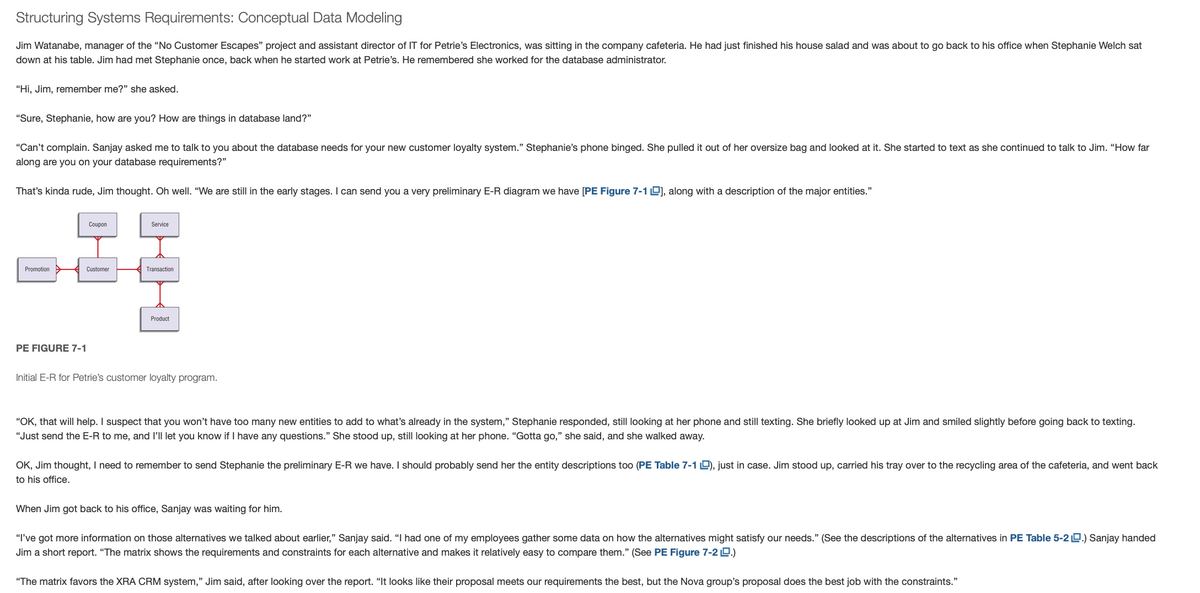Review the data-flow diagrams given to you by your instructor. Study the data flows and data stored in these diagrams and decide whether you agree with the team’s conclusion that the only six entity types needed are listed in the case and in PE Figure 7-1. If you disagree, define additional entity types, explain why they are necessary, and modify PE Figure 7-1 accordingly
Review the data-flow diagrams given to you by your instructor. Study the data flows and data stored in these diagrams and decide whether you agree with the team’s conclusion that the only six entity types needed are listed in the case and in PE Figure 7-1. If you disagree, define additional entity types, explain why they are necessary, and modify PE Figure 7-1 accordingly
Database Systems: Design, Implementation, & Management
12th Edition
ISBN:9781305627482
Author:Carlos Coronel, Steven Morris
Publisher:Carlos Coronel, Steven Morris
Chapter9: Database Design
Section: Chapter Questions
Problem 7P
Related questions
Question
7-48. Review the data-flow diagrams given to you by your instructor. Study the data flows and data stored in these diagrams and decide whether you agree with the team’s conclusion that the only six entity types needed are listed in the case and in PE Figure 7-1. If you disagree, define additional entity types, explain why they are necessary, and modify PE Figure 7-1 accordingly.

Transcribed Image Text:PE TABLE 7-1:
Entity Descriptions for the Preliminary E-R Diagram for Petrie's Customer Loyalty System
Entity
Description
Coupon
A coupon is a special promotion created specifically for an individual customer. A coupon is for a set dollar amount, for example, $10. The customer may use it like cash or like a dollars-off promotion when purchasing products or services.
Coupons can only be created for an individual customer based on the points in his or her customer loyalty account. For each dollar value of a coupon, a certain number of points must be redeemed. Coupons must be accounted for when
created and when redeemed.
Customer
A customer is someone who buys products and/or services from Petrie's Electronics. Customers include both online customers and those who shop in Petrie's brick-and-mortar stores.
Product
An item made available for sale to a Petrie's customer. For example, a product is a 40" Sony LCD HD television. Products can be purchased online or in brick-and-mortar stores.
Promotion
A promotion is a special incentive provided to a customer to entice the customer into buying a specific product or service. For example, a promotion intended to sell Blu-ray disks may involve 2-for-1 coupons. Promotions are targeted to all
customers, or to subsets of customers, not just to individual customers.
Service
A job performed by one of Petrie's associates for a customer. For example, upgrading the memory in a computer by installing new memory cards is a service that Petrie's provides for a fee. Services may only be ordered and performed in
brick-and-mortar stores, not online.
Transaction
A record that a particular product or service was sold to a specified customer on a particular date. A transaction may involve more than one product or service, and it may involve more than one of a particular kind of product or service. For
example, one transaction may involve blank DVDS and prerecorded DVDS, and the prerecorded DVDS may all be of the same movie. For members of the loyalty program, each transaction is worth a number of points, depending on the dollar
value of the transaction.
Alternative B
Alternative A SBSI
Rating
Nova
Score
Criteria
Weight
XRA
Alternative
Rating
Score
Rating
Score
Requirements
Effective customer
15
incentives
Easy for customers
75
4.
60
4
60
10
10
to use
3
30
40
5
50
Proven performance
Easy to implement
Scalable
Vendor support
40
50
3
30
15
4
20
3
15
36
10
30
40
30
30
10
30
40
3
60
220
250
215
Constraints
45
30
75
40
Cost to buy
Cost to operate
Time to implement
Staff to implement
15
3
60
3
4
4
10
40
4
3
15
15
3
15
10
3
30
4
3
30
40
155
40
120
160
Total
100
340
405
375
PE FIGURE 7-2
Evaluation matrix for customer loyalty proposals.
"Yes, but just barely," Sanjay said. “There is only a five-point difference between XRA and Nova, so they are pretty comparable when it comes to constraints. But I think the XRA system has a pretty clear advantage in meeting our requirements."
"XRA seems to be pretty highly rated in your matrix in terms of all of the requirements. You have XRA ranked better than the other two proposals for implementation, scalability, and vendor support," Jim said. “The '5' you gave XRA for proven performance is
one of the few '5s' you have in your whole matrix."
"That's because XRA is one of the best companies in the industry to work with," Sanjay responded, "The company's reputation is stellar."
"This looks really promising," Jim said. "Let's see if reality matches what we have here. It's time to put together the formal request for proposal. I'll get that work started today. I hope that all three of these companies decide to bid."

Transcribed Image Text:Structuring Systems Requirements: Conceptual Data Modeling
Jim Watanabe, manager of the "No Customer Escapes" project and assistant director of IT for Petrie's Electronics, was sitting in the company cafeteria. He had just finished his house salad and was about to go back to his office when Stephanie Welch sat
down at his table. Jim had met Stephanie once, back when he started work at Petrie's. He remembered she worked for the database administrator.
"Hi, Jim, remember me?" she asked.
"Sure, Stephanie, how are you? How are things in database land?"
"Can't complain. Sanjay asked me to talk to you about the database needs for your new customer loyalty system." Stephanie's phone binged. She pulled it out of her oversize bag and looked at it. She started to text as she continued to talk to Jim. “How far
along are you on your database requirements?"
That's kinda rude, Jim thought. Oh well. "We are still in the early stages. I can send you a very preliminary E-R diagram we have [PE Figure 7-1 D), along with a description of the major entities."
Coupon
Service
Promotion
Customer
Transaction
Product
PE FIGURE 7-1
Initial E-R for Petrie's customer loyalty program.
"OK, that will help. I suspect that you won't have too many new entities to add to what's already in the system," Stephanie responded, still looking at her phone and still texting. She briefly looked up at Jim and smiled slightly before going back to texting.
"Just send the E-R to me, and l'll let you know if I have any questions." She stood up, still looking at her phone. "Gotta go," she said, and she walked away.
OK, Jim thought, I need to remember to send Stephanie the preliminary E-R we have. I should probably send her the entity descriptions too (PE Table 7-1 L), just in case. Jim stood up, carried his tray over to the recycling area of the cafeteria, and went back
to his office.
When Jim got back to his office, Sanjay was waiting for him.
"I've got more information on those alternatives we talked about earlier," Sanjay said. "I had one of my employees gather some data on how the alternatives might satisfy our needs." (See the descriptions of the alternatives in PE Table 5-2 D.) Sanjay handed
Jim a short report. "The matrix shows the requirements and constraints for each alternative and makes it relatively easy to compare them." (See PE Figure 7-2 D.)
"The matrix favors the XRA CRM system," Jim said, after looking over the report. "It looks like their proposal meets our requirements the best, but the Nova group's proposal does the best job with the constraints."
Expert Solution
This question has been solved!
Explore an expertly crafted, step-by-step solution for a thorough understanding of key concepts.
This is a popular solution!
Trending now
This is a popular solution!
Step by step
Solved in 4 steps with 2 images

Knowledge Booster
Learn more about
Need a deep-dive on the concept behind this application? Look no further. Learn more about this topic, computer-science and related others by exploring similar questions and additional content below.Recommended textbooks for you

Database Systems: Design, Implementation, & Manag…
Computer Science
ISBN:
9781305627482
Author:
Carlos Coronel, Steven Morris
Publisher:
Cengage Learning

Principles of Information Systems (MindTap Course…
Computer Science
ISBN:
9781305971776
Author:
Ralph Stair, George Reynolds
Publisher:
Cengage Learning

Fundamentals of Information Systems
Computer Science
ISBN:
9781337097536
Author:
Ralph Stair, George Reynolds
Publisher:
Cengage Learning

Database Systems: Design, Implementation, & Manag…
Computer Science
ISBN:
9781305627482
Author:
Carlos Coronel, Steven Morris
Publisher:
Cengage Learning

Principles of Information Systems (MindTap Course…
Computer Science
ISBN:
9781305971776
Author:
Ralph Stair, George Reynolds
Publisher:
Cengage Learning

Fundamentals of Information Systems
Computer Science
ISBN:
9781337097536
Author:
Ralph Stair, George Reynolds
Publisher:
Cengage Learning

Fundamentals of Information Systems
Computer Science
ISBN:
9781305082168
Author:
Ralph Stair, George Reynolds
Publisher:
Cengage Learning

Database Systems: Design, Implementation, & Manag…
Computer Science
ISBN:
9781285196145
Author:
Steven, Steven Morris, Carlos Coronel, Carlos, Coronel, Carlos; Morris, Carlos Coronel and Steven Morris, Carlos Coronel; Steven Morris, Steven Morris; Carlos Coronel
Publisher:
Cengage Learning